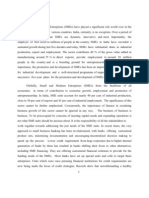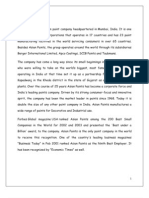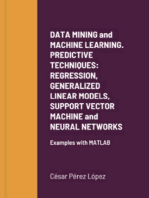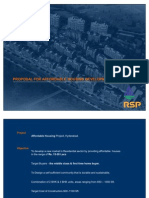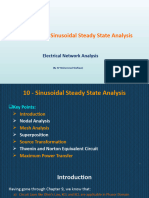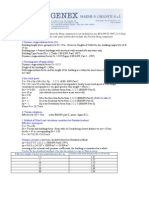0 ratings0% found this document useful (0 votes)
133 viewsSimulation
Simulation is a representation of reality using a model that reacts similarly to reality under given conditions. It is used when experimentation is not possible or when analytical solutions are unknown. The steps of Monte-Carlo simulation include obtaining variable probabilities and converting them to cumulative probabilities, generating random numbers, mapping random numbers to intervals based on cumulative probabilities, and running simulations or trials. An example simulates cake demand over 10 days using random numbers to determine daily demand, compares it to a stock of 30 cakes per day, and calculates average demand.
Uploaded by
rakeshnandiymailCopyright
© Attribution Non-Commercial (BY-NC)
We take content rights seriously. If you suspect this is your content, claim it here.
Available Formats
Download as PPT, PDF, TXT or read online on Scribd
0 ratings0% found this document useful (0 votes)
133 viewsSimulation
Simulation is a representation of reality using a model that reacts similarly to reality under given conditions. It is used when experimentation is not possible or when analytical solutions are unknown. The steps of Monte-Carlo simulation include obtaining variable probabilities and converting them to cumulative probabilities, generating random numbers, mapping random numbers to intervals based on cumulative probabilities, and running simulations or trials. An example simulates cake demand over 10 days using random numbers to determine daily demand, compares it to a stock of 30 cakes per day, and calculates average demand.
Uploaded by
rakeshnandiymailCopyright
© Attribution Non-Commercial (BY-NC)
We take content rights seriously. If you suspect this is your content, claim it here.
Available Formats
Download as PPT, PDF, TXT or read online on Scribd
You are on page 1/ 10
Why Simulation?
This is a fundamental and quantitative way to
understand complex systems/phenomena which is
complementary to the traditional approaches of
theory and experiment. Simulation (Sim.) is
concerned with powerful methods of analysis
designed to exploit high performance computing.
This approach is becoming increasingly widespread
in basic research and advanced technological
applications, cross cutting the fields of physics,
chemistry, mechanics, engineering, and biology.
Simulation
Simulation is a representation of reality
through the use of a model or other device
which will react in the same manner as reality
under a given set of condition.
Simulation is also defined as the use of a
system model that has the designed
characteristics of reality in order to produce
the essence of actual operation.
Simulation is used under two
conditions.
First, when experimentation is not possible. Note
that if we can do a real experiment, the results
would obviously be better than simulation.
Second condition for using simulation is when the
analytical solution procedure is not known. If
analytical formulas are known then we can find
the actual expected value of the results quickly by
using the formulas. In simulation we can hope to
get the same results after simulating thousands of
times.
Following are the steps involved in
Monte-Carlo simulation:-
Step I. Obtain the frequency or probability of all the
important variables from the historical sources.
Step II. Convert the respective probabilities of the various
variables into cumulative problems.
Step III. Generate random numbers for each such variable.
Step IV. Based on the cumulative probability distribution
table obtained in Step II, obtain the interval (i.e.; the range)
of the assigned random numbers.
Step V. Simulate a series of experiments or trails.
xample 1
New Delhi Bakery House keeps stock of a popular brand of
cake. Previous experience indicates the daily demand as
given below:
Consider the following sequence of random numbers: R. No.
: 21, 27, 47, 54, 60, 39, 43, 91, 25, 20.
Using this sequence, simulate the demand for the next 10
days. Find out the stock situation if the owner of the bakery
house decides to make 30 cakes every day. Also estimate
the daily average demand for the cakes on the basis of
simulated data.
Solution :
Total demand = 320
Average demand = Total demand / no. of
days
The daily average demand for the cakes =
320 / 10 = 32 cakes.
You might also like
- An Introduction to Statistical Computing: A Simulation-based ApproachFrom EverandAn Introduction to Statistical Computing: A Simulation-based ApproachNo ratings yet
- Machine Learning with Clustering: A Visual Guide for Beginners with Examples in PythonFrom EverandMachine Learning with Clustering: A Visual Guide for Beginners with Examples in PythonNo ratings yet
- Métodos numéricos aplicados a Ingeniería: Casos de estudio usando MATLABFrom EverandMétodos numéricos aplicados a Ingeniería: Casos de estudio usando MATLAB5/5 (1)
- Top 20 MS Excel VBA Simulations, VBA to Model Risk, Investments, Growth, Gambling, and Monte Carlo AnalysisFrom EverandTop 20 MS Excel VBA Simulations, VBA to Model Risk, Investments, Growth, Gambling, and Monte Carlo Analysis2.5/5 (2)
- Advanced Dynamic-System Simulation: Model Replication and Monte Carlo StudiesFrom EverandAdvanced Dynamic-System Simulation: Model Replication and Monte Carlo StudiesNo ratings yet
- Multiple Models Approach in Automation: Takagi-Sugeno Fuzzy SystemsFrom EverandMultiple Models Approach in Automation: Takagi-Sugeno Fuzzy SystemsNo ratings yet
- Process Performance Models: Statistical, Probabilistic & SimulationFrom EverandProcess Performance Models: Statistical, Probabilistic & SimulationNo ratings yet
- Secrets of Statistical Data Analysis and Management Science!From EverandSecrets of Statistical Data Analysis and Management Science!No ratings yet
- DATA MINING AND MACHINE LEARNING. PREDICTIVE TECHNIQUES: REGRESSION, GENERALIZED LINEAR MODELS, SUPPORT VECTOR MACHINE AND NEURAL NETWORKSFrom EverandDATA MINING AND MACHINE LEARNING. PREDICTIVE TECHNIQUES: REGRESSION, GENERALIZED LINEAR MODELS, SUPPORT VECTOR MACHINE AND NEURAL NETWORKSNo ratings yet
- Python Machine Learning: Machine Learning Algorithms for Beginners - Data Management and Analytics for Approaching Deep Learning and Neural Networks from ScratchFrom EverandPython Machine Learning: Machine Learning Algorithms for Beginners - Data Management and Analytics for Approaching Deep Learning and Neural Networks from ScratchNo ratings yet
- Six Sigma Yellow Belt: Introduction to Lean six Sigma Methodology for BeginnersFrom EverandSix Sigma Yellow Belt: Introduction to Lean six Sigma Methodology for BeginnersNo ratings yet
- Acceptance-Rejection Sampling and Multi-dimensional Monte Carlo Integrations Utilizing Mathematica®From EverandAcceptance-Rejection Sampling and Multi-dimensional Monte Carlo Integrations Utilizing Mathematica®No ratings yet
- Proposal For Affordable Housing Development at Hyderabad100% (1)Proposal For Affordable Housing Development at Hyderabad41 pages
- MACHINE LEARNING FOR BEGINNERS: A Practical Guide to Understanding and Applying Machine Learning Concepts (2023 Beginner Crash Course)From EverandMACHINE LEARNING FOR BEGINNERS: A Practical Guide to Understanding and Applying Machine Learning Concepts (2023 Beginner Crash Course)No ratings yet
- DATA MINING and MACHINE LEARNING. PREDICTIVE TECHNIQUES: ENSEMBLE METHODS, BOOSTING, BAGGING, RANDOM FOREST, DECISION TREES and REGRESSION TREES.: Examples with MATLABFrom EverandDATA MINING and MACHINE LEARNING. PREDICTIVE TECHNIQUES: ENSEMBLE METHODS, BOOSTING, BAGGING, RANDOM FOREST, DECISION TREES and REGRESSION TREES.: Examples with MATLABNo ratings yet
- SuridaSocial and Individual Bilingualism in The Deaf WorldNo ratings yetSuridaSocial and Individual Bilingualism in The Deaf World8 pages
- DEEP LEARNING TECHNIQUES: CLUSTER ANALYSIS and PATTERN RECOGNITION with NEURAL NETWORKS. Examples with MATLABFrom EverandDEEP LEARNING TECHNIQUES: CLUSTER ANALYSIS and PATTERN RECOGNITION with NEURAL NETWORKS. Examples with MATLABNo ratings yet
- Multi-dimensional Monte Carlo Integrations Utilizing MathematicaFrom EverandMulti-dimensional Monte Carlo Integrations Utilizing MathematicaNo ratings yet
- Minitab® and Lean Six Sigma: A Guide to Improve Business Performance MetricsFrom EverandMinitab® and Lean Six Sigma: A Guide to Improve Business Performance Metrics5/5 (1)
- Applied Predictive Modeling: An Overview of Applied Predictive ModelingFrom EverandApplied Predictive Modeling: An Overview of Applied Predictive ModelingNo ratings yet
- DATA MINING and MACHINE LEARNING. CLASSIFICATION PREDICTIVE TECHNIQUES: SUPPORT VECTOR MACHINE, LOGISTIC REGRESSION, DISCRIMINANT ANALYSIS and DECISION TREES: Examples with MATLABFrom EverandDATA MINING and MACHINE LEARNING. CLASSIFICATION PREDICTIVE TECHNIQUES: SUPPORT VECTOR MACHINE, LOGISTIC REGRESSION, DISCRIMINANT ANALYSIS and DECISION TREES: Examples with MATLABNo ratings yet
- Simulating Distributional Impacts of Macro-dynamics: Theory and Practical ApplicationsFrom EverandSimulating Distributional Impacts of Macro-dynamics: Theory and Practical ApplicationsNo ratings yet
- Icrosoft Aint: Paint Brush Screenshot - Windows XPNo ratings yetIcrosoft Aint: Paint Brush Screenshot - Windows XP9 pages
- 02 - Chapter 10 Sinusoidal Steady State AnalysisNo ratings yet02 - Chapter 10 Sinusoidal Steady State Analysis15 pages
- 3 Grade Comprehensive CRCT Math Study Guide: Thousands OnesNo ratings yet3 Grade Comprehensive CRCT Math Study Guide: Thousands Ones31 pages
- Thermodynamic Analysis of Gas Turbine Powered Cogeneration SystemsNo ratings yetThermodynamic Analysis of Gas Turbine Powered Cogeneration Systems6 pages
- Module 2 (Mathematics, Science, and Technology)No ratings yetModule 2 (Mathematics, Science, and Technology)7 pages
- Stress (Mechanics) - Wikipedia, The Free EncyclopediaNo ratings yetStress (Mechanics) - Wikipedia, The Free Encyclopedia10 pages
- Bukit Panjang Government High School: Secondary Four Express & Five Normal Academic (2010)No ratings yetBukit Panjang Government High School: Secondary Four Express & Five Normal Academic (2010)5 pages
- Cefoperazone Sodium For Injection: Operating ConditionsNo ratings yetCefoperazone Sodium For Injection: Operating Conditions2 pages

















